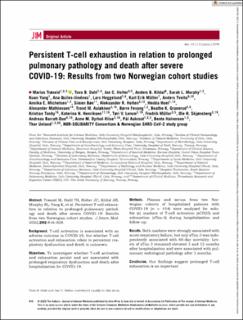Persistent T-cell exhaustion in relation to prolonged pulmonary pathology and death after severe COVID-19: Results from two Norwegian cohort studies
Trøseid, Marius; Dahl, Tuva Børresdatter; Holter, Jan Cato; Kildal, Anders Benjamin; Murphy, Sarah Louise Mikalsen; Yang, Kuan; Quiles Jimenez, Ana Maria Teresa; Heggelund, Lars; Muller, Karl Erik; Tveita, Anders Aune; Michelsen, Annika Elisabet; Bøe, Simen; Holten, Aleksander Rygh; Hoel, Hedda Benedicte; Mathiessen, Alexander; Aaløkken, Trond Mogens; Fevang, Børre; Granerud, Beathe Kiland; Tonby, Kristian; Nezvalova-Henriksen, Katerina; Lerum, Tøri Vigeland; Müller, Fredrik; Skjønsberg, Ole Henning; Barratt-Due, Andreas; Riise, Anne Margarita Dyrhol; Aukrust, Pål; Halvorsen, Bente Evy; Ueland, Thor
Journal article, Peer reviewed
Published version

Åpne
Permanent lenke
https://hdl.handle.net/11250/3026999Utgivelsesdato
2022Metadata
Vis full innførselSamlinger
- Department of Clinical Science [2318]
- Registrations from Cristin [9791]
Sammendrag
Background: T-cell activation is associated with an adverse outcome in COVID-19, but whether T-cell activation and exhaustion relate to persistent respiratory dysfunction and death is unknown.
Objectives: To investigate whether T-cell activation and exhaustion persist and are associated with prolonged respiratory dysfunction and death after hospitalization for COVID-19.
Methods: Plasma and serum from two Norwegian cohorts of hospitalized patients with COVID-19 (n = 414) were analyzed for soluble (s) markers of T-cell activation (sCD25) and exhaustion (sTim-3) during hospitalization and follow-up.
Results: Both markers were strongly associated with acute respiratory failure, but only sTim-3 was independently associated with 60-day mortality. Levels of sTim-3 remained elevated 3 and 12 months after hospitalization and were associated with pulmonary radiological pathology after 3 months.
Conclusion: Our findings suggest prolonged T-cell exhaustion is an important immunological sequela, potentially related to long-term outcomes after severe COVID-19.
